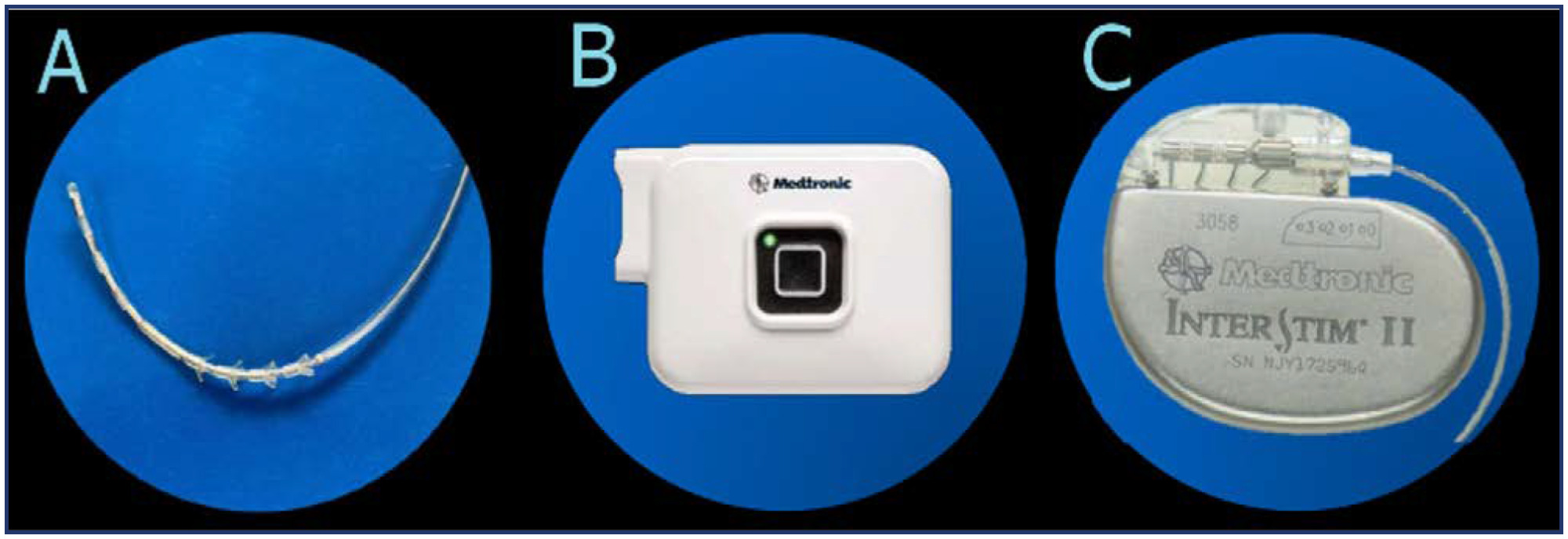-
Original Article
Sacral neuromodulation therapy for urinary and defecatory disorders: experience in a Latin American public hospital
Revista Brasileira de Ginecologia e Obstetrícia. 2024;46:e-rbgo11
00-00-2024
Summary
Original ArticleSacral neuromodulation therapy for urinary and defecatory disorders: experience in a Latin American public hospital
Revista Brasileira de Ginecologia e Obstetrícia. 2024;46:e-rbgo11
00-00-2024Views566Abstract
Objective:
To show the experience of a Latin American public hospital, with SNM in the management of either OAB, NOUR or FI, reporting feasibility, short to medium-term success rates, and complications.
Methods:
A retrospective cohort was conducted using data collected prospectively from patients with urogynecological conditions and referred from colorectal surgery and urology services between 2015 and 2022.
Results:
Advanced or basic trial phases were performed on 35 patients, 33 (94%) of which were successful and opted to move on Implantable Pulse Generator (GG) implantation. The average follow-up time after definitive implantation was 82 months (SD 59). Of the 33 patients undergoing, 27 (81%)reported an improvement of 50% or more in their symptoms at last follow-up. Moreover, 30 patients (90%) with a definitive implant reported subjective improvement, with an average PGI-I "much better" and 9 of them reporting to be "excellent" on PGI-I.
Conclusion:
SNM is a feasible and effective treatment for pelvic floor dysfunction. Its implementation requires highly trained groups and innovative leadership. At a nation-wide level, greater diffusion of this therapy among professionals is needed to achieve timely referral of patients who require it.
Key-words Electric stimulation therapyfecal incontinenceIncontinenceNon-obstructive urinary retentionoveractiveSacral neuromodulationUrinary bladderSee more
-
Artigos Originais
Relationship between anxiety and overactive bladder syndrome in older women
Revista Brasileira de Ginecologia e Obstetrícia. 2014;36(7):310-314
07-01-2014
Summary
Artigos OriginaisRelationship between anxiety and overactive bladder syndrome in older women
Revista Brasileira de Ginecologia e Obstetrícia. 2014;36(7):310-314
07-01-2014DOI 10.1590/SO100-720320140005008
Views145See morePURPOSE:
The objective of this study was to investigate the relationship between overactive bladder syndrome and anxiety in older women.
METHODS:
Of the 198 older women who were invited, 29 were excluded and 166 were then divided into two groups according to the Advanced Questionnaire of Overactive Bladder (OAB-V8): one group with overactive bladder symptoms (OAB-V8≥8) and the other without the symptoms of an overactive bladder (OAB-V8<8). The purpose was to conduct a frequency analysis and to investigate the relation of the social demographic data and anxiety in the two groups. The Beck Anxiety Inventory (BAI) was used to evaluate the level of anxiety. The Kolmogorov-Smirnov test was used to determine the distribution of the data. The differences between the two groups for the continuous variables were analyzed by the Mann-Whitney U test, the differences for the categorical variables were analyzed by the Chi-Square test and the association between the continuous variables was analyzed by the Spearman Correlation test. The tests were two-tailed with a confidence level of 5%.
RESULTS:
Overall, the frequency of an overactive bladder was present in 117 (70.5%) of the participants. The body mass index (BMI) of the group with overactive bladder symptoms was significantly higher than the BMI of those without these symptoms (p=0.001). A higher prevalence of mild, moderate and severe anxiety was observed among older women with overactive bladder symptoms. In addition, the overactive bladder symptoms group presented a positive low correlation with anxiety symptoms (r=0.345) and with BMI (r=0.281). There was a small correlation between BMI and anxiety symptoms (r=0.164).
CONCLUSIONS:
Overactive bladder syndrome was prevalent among older women and the existence of these symptoms was linked to the presence of mild, moderate and/or severe anxiety symptoms.
-
Artigos Originais
Detrusor overactivity: comparative study among oxybutynin, functional electrostimulation and pelvic floor training. A randomized clinical trial
Revista Brasileira de Ginecologia e Obstetrícia. 2007;29(9):452-458
12-05-2007
Summary
Artigos OriginaisDetrusor overactivity: comparative study among oxybutynin, functional electrostimulation and pelvic floor training. A randomized clinical trial
Revista Brasileira de Ginecologia e Obstetrícia. 2007;29(9):452-458
12-05-2007DOI 10.1590/S0100-72032007000900003
Views126PURPOSE: to evaluate and to compare the effectiveness of oxybutynin, electrostimulation (ES) and pelvic floor training (PFT) in the management of women with detrusor overactivity. METHODS: a total of 64 women, 35 to 80 years old, were enrolled in this randomized prospective trial. Patients were randomized in three groups: Oxybutynin (n=22), ES (n=21) and PFT (n=21). There were no statistical differences between the three groups with regards to race (p=0.948), age (p=0.747), hormonal status (p=0.813), time of symptomatology (p=0.789), previous surgery for urinary incontinence (p=0.993), or body mass index (p=0.897). Patients were assessed before and after treatment by urodynamic test, a seven-day voiding diary, and subjective response. The duration of the treatment was twelve weeks. For statistical analyses, the Pearson chi2, analysis of variance (ANOVA) and the paired t-test were used. RESULTS: there was a decrease in the urge-incontinence episodes and in the number of pads required in all groups (p<0.05). There was reduction in the frequency of micturition in the Oxybutynin Group (p=0.014). Oxybutynin and ES Groups had reduction in nocturia episodes (p=0.003 and p=0.036, respectively). There were no significant differences in improvement between the three groups (p>0.05). Urgency was resolved in 14 (63.6%), 11 (52.4%) and 12 (57.1%) patients of the Oxybutynin, ES and PFT Groups, respectively, without differences among the groups (p=0.754). Subjectively, 17 (77.3%), 11 (52.4%) and 16 (76.2%) women who had accomplished oxybutynin, ES and PFT, respectively, were satisfied, without differences among the groups (p = 0.142). Urodynamic was normal in 8 (36.4%), 12 (57.1%) and 11 (52.4%) patients of the Oxybutynin, ES and PFT Groups, respectively. This urodynamic analysis revealed no differences between the three groups (p=0.358). The reduction of urge-incontinence correlated with patient satisfaction (p<0.05). CONCLUSIONS: treatments were equally effective; reduction of urge-incontinence was correlated with patient satisfaction.
Key-words Cholinergic antagonistsElectric stimulationoveractivePelvic floorPhysical therapy modalitiesUrinary bladderSee more


